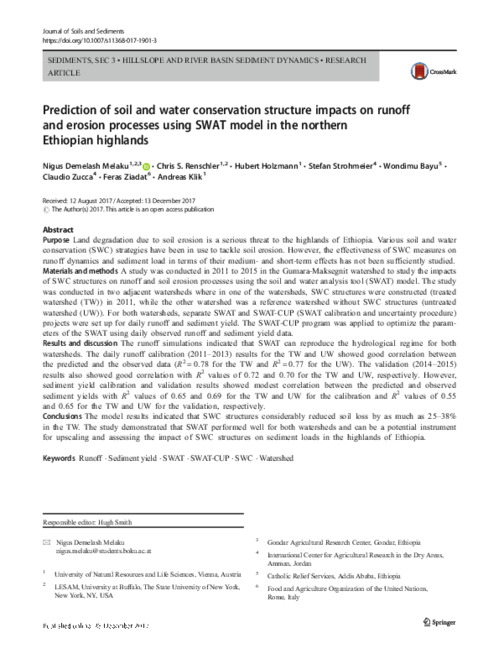Prediction of soil and water conservation structure impacts on runoff and erosion processes using SWAT model in the Northern Ethiopian highlands
Abstract
Purpose Land degradation due to soil erosion is a serious threat to the highlands of Ethiopia. Various soil and water conservation (SWC) strategies have been in use to tackle soil erosion. However, the effectiveness of SWC measures on runoff dynamics and sediment load in terms of their medium- and short-term effects has not been sufficiently studied.
Materials and methods A study was conducted in 2011 to 2015 in the Gumara-Maksegnit watershed to study the impacts of SWC structures on runoff and soil erosion processes using the soil and water analysis tool (SWAT) model. The study was conducted in two adjacent watersheds where in one of the watersheds, SWC structures were constructed (treated watershed (TW)) in 2011, while the other watershed was a reference watershed without SWC structures (untreated watershed (UW)). For both watersheds, separate SWAT and SWAT-CUP (SWAT calibration and uncertainty procedure) projects were set up for daily runoff and sediment yield. The SWAT-CUP program was applied to optimize the parameters
of the SWAT using daily observed runoff and sediment yield data.
Results and discussion The runoff simulations indicated that SWAT can reproduce the hydrological regime for both watersheds. The daily runoff calibration (2011–2013) results for the TW and UW showed good correlation between the predicted and the observed data (R2 = 0.78 for the TW and R2 = 0.77 for the UW). The validation (2014–2015) results also showed good correlation with R2 values of 0.72 and 0.70 for the TW and UW, respectively. However, sediment yield calibration and validation results showed modest correlation between the predicted and observed sediment yields with R2 values of 0.65 and 0.69 for the TW and UW for the calibration and R2 values of 0.55 and 0.65 for the TW and UW for the validation, respectively.
Conclusions The model results indicated that SWC structures considerably reduced soil loss by as much as 25–38% in the TW. The study demonstrated that SWAT performed well for both watersheds and can be a potential instrument for upscaling and assessing the impact of SWC structures on sediment loads in the highlands of Ethiopia

